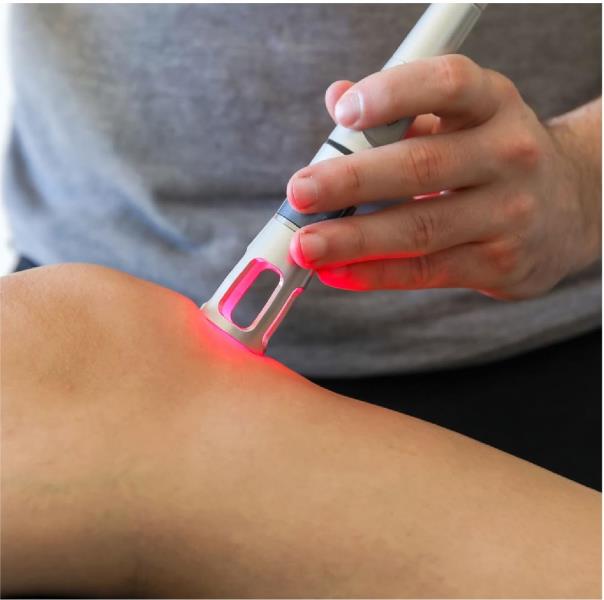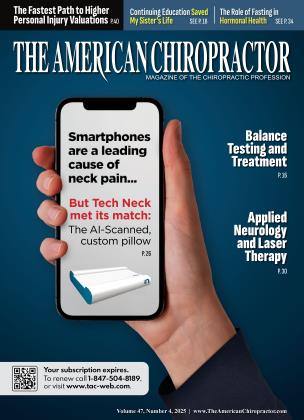
“A common misconception about the emerging laser industry is the idea that laser effectiveness is based on more power output.”
CHIROPRACTIC CARE CONTINUES TO EVOLVE as an integrative approach to musculoskeletal and neurological health. One of the most significant advancements in recent years has been the application of low-level laser therapy (LLLT), particularly the emerging role of violet and green wavelengths.
Violet and green wavelengths provide enhanced clinical effects, including antimicrobial properties, improved fat metabolism, reduced inflammation, and neurological benefits. This article explores the scientific and clinical advantages of these wavelengths, their FDA-cleared research, and their usefulness for integrative applied neurology.
Traditional laser therapy has primarily utilized red and infrared wavelengths, but new research highlights the superior benefits of violet (405nm) and green (520nm) lasers. These wavelengths interact uniquely with cellular structures, providing distinct advantages:
• Violet wavelength (405nm): Exhibits strong antimicrobial effects, making it valuable for addressing infections while also influencing even more pronounced mitochondrial function over red-only wavelengths.
• Green wavelength (520nm): Enhances fat metabolism, reduces inflammation, and modulates neurological function, supporting conditions like neuropathy and chronic pain syndromes.
• Improved cellular interaction: These wavelengths stimulate different chromophores within cells, promoting ATP production, reducing oxidative stress, and supporting neuroplasticity.
A common misconception about the emerging laser industry is the idea that laser effectiveness is based on more power output. To the contrary, most brain studies, as well as other tissues and systems, show that the ideal dose is somewhere between 0.5 and 10 J/cm2.
It should be clearly stated that the higher the energy per photon, the more effective the laser is. That is the primary reason using a green and violet laser works even better than just using red or even red-violet laser devices.
That is not to dismiss the abundance of research behind red devices, but many clinics are adding violet and green lasers to their practice and having even better results. This is backed by FDA-clearance studies comparing red versus red/ violet versus green/violet devices, with green/violet devices demonstrating even better outcomes than red or red/violet.
Low-level lasers can be used as a stand-alone treatment in practice or in concert with other modalities. They are emerging as one of the most promising tools to protect and repair the brain and nervous system.
“Low-level lasers can be used as a standalone treatment in practice or in concert with other modalities. They are emerging as one of the most promising tools to protect and repair the brain and nervous system.”
Recent FDA-cleared studies validate the clinical efficacy of laser therapy for a wide range of conditions, reinforcing its role in mainstream health care. Of the 26 major FDA clearances for low-level laser devices, 22 are held by a single company. Because they are a class 2 laser, they have demonstrated excellent results and never had a reported adverse event in any of their studies. Key findings of these FDA clearances include:
Laser therapy is increasingly recognized for its impact on brain function, pain modulation, and neuroplasticity. In integrative applied neurology, it plays a crucial role by:
• Enhancing neuroplasticity: Stimulating brain regions associated with motor control, cognition, and autonomic function.
• Modulating pain perception: Regulating inflammatory pathways and immune function.
• Improving performance and Injury recovery
For chiropractors and integrative practitioners, proper implementation of laser therapy is essential to maximize patient outcomes. Key considerations include:
• Technique and protocols: Adjusting treatment parameters based on condition-specific needs ensures optimal results.
• Combination therapies: Integrating laser therapy with chiropractic adjustments, functional movement training, and nutritional support enhances therapeutic efficacy.
• Patient education and compliance: Educating patients on the benefits of laser therapy can improve adherence to treatment plans and long-term health outcomes.
The integration of violet and green wavelength laser therapy into integrative applied neurology represents a significant advancement in patient care. By leveraging photobiomodulation’s ability to enhance neuroplasticity, reduce inflammation, and promote cellular healing, practitioners can optimize treatment outcomes for complex neurological and musculoskeletal conditions. As research continues to evolve, chiropractors must remain informed on best practices to maximize patient benefits.

Dr. Trevor Berry is a board-certified Diplomate of Neurology through ACNB. He is the founder of Arizona Chiropractic Neurology Center and has been in practice since 1997 in Chandler, Arizona. He’s been an international speaker since 2010, lecturing on nutrition and functional medicine, laboratory testing, neurological diagnostic testing, functional neurology, and low-level laser therapy. Dr. Berry cofounded BTB Health Systems and was hired as the chief clinical officer for applied functional neurology (AFN) in 2022. He is a published researcher on low-level laser therapy and has multiple projects in the field of integrative neurology for brain-based conditions such as neurodegeneration and traumatic brain injury. Contact him at www.azchironeuro.com, [email protected], or 480-756-2600.
References
1. Gonzalez-Lima F, Barrett DW. Augmentation of cognitive brain functions with transcranial lasers. Front Syst Neurosci. 2014 Mar 14;8:36. doi: 10.3389/fnsys.2014.00036. PMID: 24672439; PMCID: PMC3953713.
2. Hamblin MR. Mechanisms and applications of the anti-inflammatory effects of photobiomodulation. AIMS Biophys. 2017;4(3):337-361. doi: 10.3934/biophy.2017.3.337. Epub 2017 May 19. PMID: 28748217; PMCID: PMC5523874.
3. Huang YY, Sharma SK, Carroll J, Hamblin MR. Biphasic dose response in low-level light therapy — an update. Dose Response. 2011;9(4):602-18. doi: 10.2203/ dose-response. 11-009.Hamblin. Epub 2011 Sep 2. PMID: 22461763; PMCID: PMC3315174.
4. Naeser MA, Saltmarche A, Krengel MH, Hamblin MR, Knight JA. Improved cognitive function after transcranial, light-emitting diode treatments in chronic, traumatic brain injury: two case reports. Photomed Laser Surg. 2011 May;29(5):351-8. doi: 10.1089/pho.2010.2814. Epub 2010 Dec 23. PMID: 21182447; PMCID: PMC3104287.
 View Full Issue
View Full Issue









